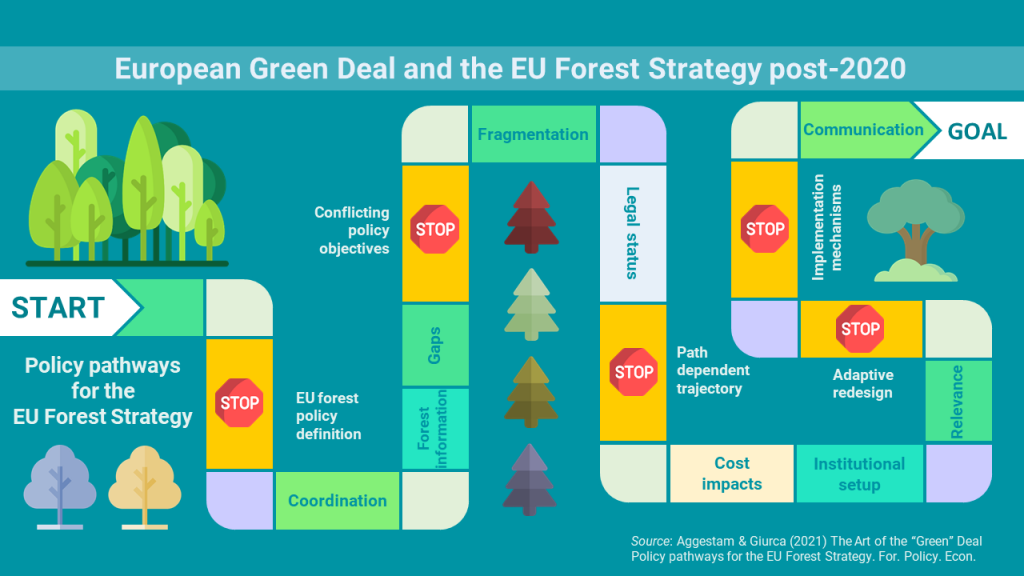The Art of the “Green” Deal
Policy pathways for a third EU Forest Strategy.
The European Green Deal is being promoted as a cornerstone for European policy over the next five years, setting out an ambitious package of measures that aim to facilitate a sustainable green transition in the EU. One of the many actions highlighted under the Green Deal is the third EU Forest Strategy, a non-legally binding (or soft) policy instrument for which the European Commission will prepare a proposal in 2021.
The ongoing policy discussion in Brussels is set against the backdrop of a new EU Biodiversity Strategy, an EU taxonomy for sustainable activities, the 2050 Climate Change Mitigation Strategy, the Circular Economy Action Plan and the recently adopted Adaptation Strategy. All these initiatives (and more) are being pushed as components of the Green Deal. However, whether and how these initiatives and strategies will influence the new EU Forest Strategy is still an unknown.
We have set out to investigate how forests have been framed in the Green Deal and to cast light on its potential role in the development of the third EU Forest Strategy. This has, in a sense, been a prospective study using the pathways to sustainability approach to consider alternative pathways for the next Strategy. This was achieved by reviewing the Green Deal itself, what representative organisations have said about forests and the Green Deal, and what the scientific work on the two preceding Strategies can teach us.

Results indicate that the Green Deal hardly gives any consideration to the multiple benefits forests provide to society and how the forest-based sector could contribute to the Green Deal. The scientific literature provides several potential policy pathways related to coordinating policy objectives, forest governance, cost impacts, data accessibility and harmonisation, knowledge production and communication. However, given the prevailing narrative around the role of forests in the Green Deal, many of the problems that have been articulated by forest policy researchers over the last 20 to 30 years fundamentally remain the same, such as policy incoherence and a lack of coordination and integration. For instance, even the recent Council conclusion on the Strategy note the “need to strategically address increasing fragmentation of EU forest-related policies and improve their coordination and coherence” (para. d). This is a priority that can be traced back as far as to the first Strategy in 1998, suggesting that we may not have progressed very far.
The conflicting policy objectives that characterise EU forest-related policy corresponds to a deeper governance challenge that cannot be addressed without changing the tools and mechanisms that are available to implement the Strategy. This cannot be stressed enough. Simply having a shared agenda on forests is not enough, particularly, if the third Strategy wishes to have an impact on the European Community.
Even more, if we set aside the legal challenges (e.g., issues surrounding competence), some basic building blocks are missing. For instance, the absence of a definition for what EU forest-related policy should entail for the European Community makes it difficult to clearly delimit or focus the Strategy on a few concrete measures or provide a better strategic vison for forests. Also, there is limited understanding of how EU Member States and the EU’s political priorities mix at the national level and whether vertical and horizontal coherence between policy domains and policy instruments can be achieved at all. Nevertheless, having said all this, we argue that the time is ripe for EU action to come up with a common strategic vison on forests, and the Green Deal may very well provide the gateway for this to happen. In either case, a redesign of the Strategy itself will be required to make it more adaptive, relevant and effective.
The ‘Art of the “Green” Deal - Policy pathways for a third EU Forest Strategy’ has been published in Forest Policy and Economics, 128, July 2021, 102456. Filip Aggestam, at the Institute of Forest, Environmental and Natural Resource Policy at the University of Natural Resources and Life Sciences (BOKU) and the European Forest Institute (EFI) Forest Policy Research Network, was the lead author, together with his co-author, Alex Giurca, at the Chair of Forest and Environmental Policy at the University of Freiburg. Free download available for the next 50 days: https://authors.elsevier.com/a/1d0J74y2D1Ynwr